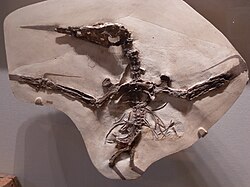Pteranodon gracilis
|
Nyctosaurus Temporal range: Late Cretaceous, 85–84.5 Ma |
|
|---|---|
 |
|
| Carnegie Museum fossil specimen of N. gracilis, CM 11422 | |
| Scientific classification | |
| Kingdom: | Animalia |
| Phylum: | Chordata |
| Class: | Reptilia |
| Order: | †Pterosauria |
| Suborder: | †Pterodactyloidea |
| Family: | †Nyctosauridae |
| Genus: |
†Nyctosaurus Marsh, 1876 |
| Type species | |
|
Nyctosaurus gracilis Marsh, 1876 |
|
| Species | |
|
N. gracilis (Marsh, 1876 [originally Pteranodon]) |
|
| Synonyms | |
|
Nyctodactylus Marsh, 1881 |
|
N. gracilis (Marsh, 1876 [originally Pteranodon])
N. nanus (Marsh, 1881 [originally Pteranodon])
"N." lamegoi Price, 1953
N. bonneri? Miller, 1972
Nyctodactylus Marsh, 1881
Nyctosaurus is a genus of pterodactyloid pterosaur, the remains of which have been found in the Niobrara Formation of the mid-western United States, which, during the late Cretaceous Period, was covered in an extensive shallow sea. The genus Nyctosaurus has had numerous species referred to it, though how many of these may actually be valid requires further study. At least one species possessed an extraordinarily large antler-like cranial crest.
Nyctosaurus was similar in anatomy to its close relative and contemporary, Pteranodon. It had relatively long wings, similar in shape to modern seabirds. However, it was smaller overall than Pteranodon, with an adult wingspan of 2 meters (6.6 feet) and a maximum weight of about 1.86 kg. The overall body length was 37 cm. Some specimens preserve a distinctive crest, at least 55 cm tall in old adults, relatively gigantic compared to the rest of the body and over three times the length of the head. The crest is composed of two long, grooved spars, one pointed upward and the other backward, arising from a common base projecting up and back from the back of the skull. The two spars were nearly equal in length, and both were nearly as long or longer than the total length of the body. The upward-pointing crest spar was at least 42 cm (1.38 ft) long and the backward-pointing spar was at least 32 cm (1.05 ft) long.
The jaws of Nyctosaurus were long and extremely pointed. The jaw tips were thin and needle sharp, and are often broken off in fossil specimens, giving the appearance that one jaw is longer than the other, though in life they were probably equal in length.
Nyctosaurus is the only known pterosaur to have lost its clawed "fingers", with the exception of the wing finger (of which however the fourth phalanx was lost), which is likely to have impaired its movement on the ground, leading scientists to conjecture that it spent almost all of its time on the wing and rarely landed. In particular, the lack of claws with which to grip surfaces would have made climbing or clinging to cliffs and tree trunks impossible for Nyctosaurus.
...
Wikipedia
